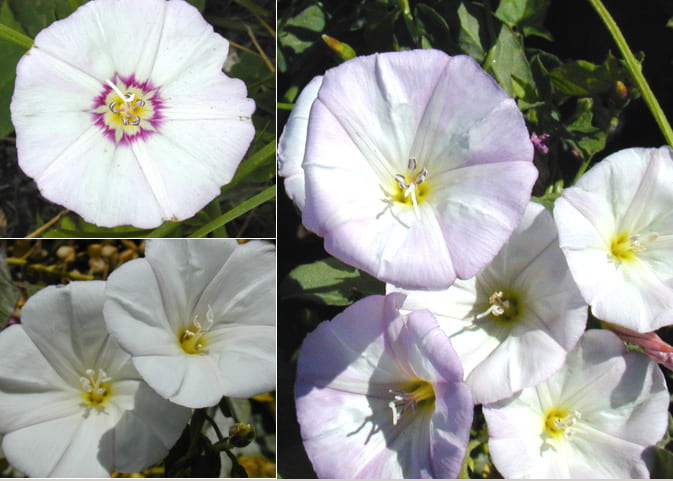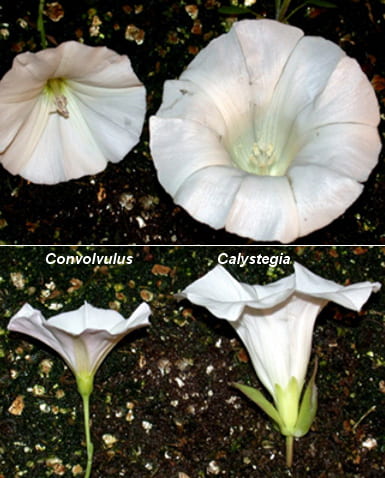There are two bindweed species that are common agricultural weeds in New York: field bindweed (Convolvulus arvensis L.) and hedge bindweed (Calystegia sepium). Both are perennial vines with extensive root systems.
Field bindweed is difficult to manage, with very deep taproots and extensive rhizomes. It is common and problematic throughout North America, occurring in many agricultural and horticultural crops, ornamental landscapes, and turf. Alkaloids found in field bindweed are mildly toxic to certain types of livestock and cause digestive disturbances. Hedge bindweed is very similar, but less of a problem in cultivated fields. It occurs in landscapes, nurseries and row crops and can often be found along fences and hedges. It prefers rich, moist lowland areas. A plant native to the eastern United States, hedge bindweed has spread throughout the US.
In New York bindweeds are common in field crops, vegetables, berries, grapes, and apples, as well as being problems along fencerows and hedgerows. Field bindweed is more common in row crops and annual vegetables, as it has a much deeper root system that survives cultivation.
Below are sections for identification of both bindweed species; key traits for differentiating the two are in bold.
Identification
Field Bindweed
Seedlings/sprouts: Field bindweed can reproduce by both seeds and rhizomes. Seeds germinate in spring and early summer, and can persist in the soil over 50 years. Shoots from rhizomes emerge in early spring and are spread by cultivation and on farm equipment and movement of topsoil. Field bindweed’s cotyledons are smooth, dark green, and relatively large. They are square to kidney-shaped with long petioles; the cotyledons have whitish veins and smooth edges, usually with a slight indentation at the tip (Fig. 1). Many bindweed plants sprout from root fragments (rhizomes); these do not have cotyledons. Young leaves are bell-shaped with petioles; leaves have lobes at the base and are 1.5 – 3.5 cm long (Fig. 2).

Fig 2. Field bindweed seedling. Cotyledons at the base of plant, with young leaves above. Photo from “Weed Identification, Biology and Management”, by Alan Watson and Antonio DiTommaso.

Fig. 1. Field bindweed cotyledons and first true leaf. Photo from “Weed Identification, Biology and Management”, by Alan Watson and Antonio DiTommaso.
Mature plant: Field bindweed stems are smooth to slightly hairy, 2-7 feet long, and trail along the ground or twine up vegetation and other objects (Fig. 4). Mature leaves are arrowhead shaped and 4-6 cm long, with lobes pointing away from the petiole at the base. Rhizomes are extensive and up to 30 feet deep. Small root fragments resprout readily.

Fig 4. Field bindweed infestation. Photo from “Weed Identification, Biology and Management”, by Alan Watson and Antonio DiTommaso.
Flowers and seeds: Plants flower from June to September, with one or two flowers forming where leaves attach to the stem (leaf axil). Flower stalks are shorter than the leaves. There are two small, leafy bracts at the base of the flower. Flower petals are white or sometimes pink, and are fused into a funnel-shaped tube at the base, forming a trumpet-like flower (Fig. 3). Flowers are about 2.5 cm (one inch) across. The fruit is an oval to rounded capsule containing 4 seeds. Seeds are 3-4mm long, rough dull gray to brown or black with one rounded side and one flattened side.

Fig 3. Field bindweed flowers, showing color variability. Photo from “Weed Identification, Biology and Management”, by Alan Watson and Antonio DiTommaso.
There have been reports outside the US of herbicide resistance, from Jordan in 2011 to paraquat (PSI Electron Diverter (D/22)).
Hedge Bindweed
Hedge bindweed is a very similar species, but has a shallower root system and is more common in uncultivated areas. Hedge bindweed has larger leaves and flowers than field bindweed. Its leaves are more strongly triangular, with sharp points at the end and angles on the lobes, and have no hairs. The rooting system of hedge bindweed is more shallow, which is why it is less common in cultivated areas. Management of the two species is similar.
Seedlings/sprouts: Hedge bindweed can reproduce by seeds or rhizomes. Seeds germinate in spring and early summer. Shoots from rhizomes emerge in early spring and are spread by cultivation and on farm equipment and movement of topsoil. Hedge bindweed cotyledons are smooth, with long petioles, almost square with a noticeable indentation at the tip, heart-shaped at base with entire margins. Young leaves are triangular, heart-shaped, or sharply lobed at the base (arrowhead shaped with basal lobes more divergent) with long petioles. Plants forming from rhizomes do not have cotyledon leaves.

Fig. 5. Hedge bindweed cotyledons and first true leaf. Photo from “Weed Identification, Biology and Management”, by Alan Watson and Antonio DiTommaso.
Mature plant: Hedge bindweed stems are smooth or hairy, and trail along the ground or climb on vegetation and other objects, 1-3 m long. Leaves are alternate, triangular-oblong, 5-10 cm long, smooth, hairless, with a pointed tip and prominent, angular, heart-shaped bases. Lobes point away from the leaf stem at the base. Rhizomes are branched and fleshy, extensive but relatively shallow, up to 30 cm dee

Fig. 6. Details of hedge bindweed; leaves, stems, flower, twining habit. Photo from “Weed Identification, Biology and Management”, by Alan Watson and Antonio DiTommaso.

Fig. 8. Hedge bindweed seedling left; on right, hedge bindweed leaf above, field bindweed leaf below. Photo from “Weed Identification, Biology and Management”, by Alan Watson and Antonio DiTommaso.
edge bindweed flowers and seeds: Plants flower from July through August, forming one flower between the stem and the leaf (leaf axil). Flower stalks are 5-15 cm. Two 1-2 cm leafy bracts conceal 5 overlapping sepals at the base of the flower. Flower petals are white or sometimes pink, and are fused into a funnel-shaped tube at the base, forming a trumpet-like flower. Flowers are 4-5 cm (1.5-2 inches) across. The fruit is an egg-shaped to rounded capsule (8 mm) containing 2-4 seeds. Seeds are 4-5 mm long, dull gray to brown or black with one rounded side and two flattened side.

Fig. 7. Field bindweed flower on left; hedge bindweed flower on right. Note difference in size and green sepals at base of flowers. Photo from “Weed Identification, Biology and Management”, by Alan Watson and Antonio DiTommaso.
Management
Management of bindweeds can be very difficult, as their extensive root systems respond to disturbance by creating more shoots, and seeds can survive for decades in the soil. The University of Nebraska has an excellent resource for field bindweed management in organic agriculture. Thurston County in Washington State developed an integrated pest management handout for field bindweed with control suggestions.
Chemical control
Cornell University’s Turfgrass and Landscape Weed ID app offers suggestions for conventional and alternative chemical control options, both for hedge bindweed and field bindweed.
In apple orchards, field bindweed can be managed using a pre-emergent spring herbicide (dichlobenil), followed by post-emergent systemic herbicides (such as 2,4-D) as bindweed emerges. See this ENYCHP Tree Fruit News article for more information.
Use this tool to look up the efficacy of herbicides on a particular weed species. For general guidance on weed control, get the latest edition of the Cornell Crop and Pest Management Guidelines.
Non-chemical control
Cornell University’s Weed Ecology and Management website provides ecological control options for bindweeds.
Non-chemical control:
Control requires constant vigilance in removing the plant top growth. Effective management also requires prevention of seed production, deep tillage of the root system to reduce stored carbohydrates, and use of desired plants to shade bindweed. To prevent bindweed from establishing, buy and plant clean seed or nursery stock, don’t allow seedlings to establish, and prevent seed production. Spot treat new infestations when they are small and easier to manage. Research on biocontrol options is ongoing to determine if long-term suppression of foliage would eventually eliminate this persistent weed.
See A Grower’s Guide to Organic Apples from Cornell for non-chemical weed control options in apple orchards.
References
Uva R H, Neal J C, DiTomaso J M. 1997. Weeds of the Northeast. Book published by Cornell University, Ithaca NY. The go-to for weed ID in the Northeast; look for a new edition sometime in 2019.
Cornell University’s Weed Ecology and Management website. Contains a wealth of information on ecological management of agricultural and garden weeds. Look for a revamp of this site in 2020 or 2021.
Cornell University’s Turfgrass and Landscape Weed ID app. Identification and control options for weeds common to turf, agriculture, and gardens in New York; uses a very simple decision tree to identify your weed.
http://www.weedscience.org/Summary/Species.aspx
Heap, I. The International Survey of Herbicide Resistant Weeds. Online. Internet. Thursday, August 22, 2019 . Available www.weedscience.org
Field bindweed (Convolvulus arvensis) Monthly Weed Post April 2019 http://msuinvasiveplants.org/extension/2019_april.html
Montana State University Weed Factsheet – Field Bindweed https://www.msuextension.org/publications/AgandNaturalResources/MT201903AG.pdf
NebFacts Bindweed Identification and Control Options for Organic Production (October 2003) https://digitalcommons.unl.edu/cgi/viewcontent.cgi?article=1047&context=extensionhist
Basedow, M and L Sosnoskie. 2020. Strategies for Dealing with Pesky Perennial Weeds. Article published in the April 2020 issue of Tree Fruit News. Covers control of yellow nutsedge, Canada thistle, field bindweed, and dandelion in apple orchards.
Peck, G M and I A Merwin. A Grower’s Guide to Organic Apples. Covers organic weed control methods for organic apple orchards.
Breth, D I and E Tee. 2016. Herbicide AI by Weed Species. This tool allows you to look up the efficacy of an herbicide active ingredient on a particular weed species.
Similar species: Wild buckwheat is another vining weed with similar leaves to hedge bindweed, but it’s annual rather than perennial and its management is different from the bindweeds. Wild buckwheat is in the buckwheat family, so it has swollen stem nodes where leaves sprout from the stem, and those nodes are covered by a papery sheath (ocrea). Wild buckwheat is easier to manage than the bindweeds.
Oregon State University has a good post with photos comparing and contrasting the three species here. The University of Maryland Cooperative Extension has a good resource for differentiating between field and hedge bindweed here.




